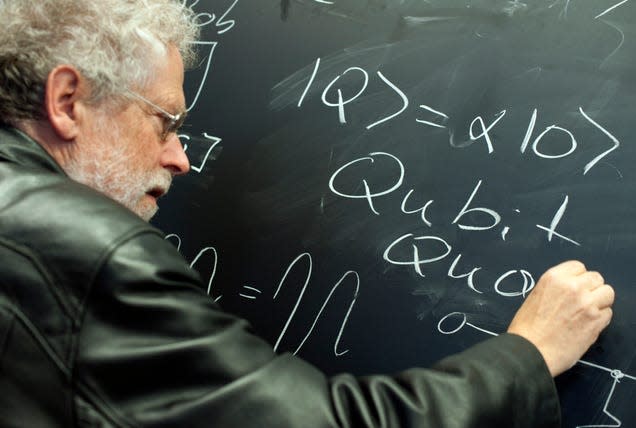The 2022 Physics Nobel winners untangled the spookiness of quantum mechanics

This year’s Nobel Prize in Physics was awarded to France’s Alain Aspect, an expert on quantum optics and atomic physics, American theoretical and experimental physicist John F. Clauser, and Austrian quatum physicist Anton Zeilinger.
On Tuesday (Oct. 4), the prestigious award went to the three “for experiments with entangled photons, establishing the violation of Bell inequalities and pioneering quantum information science.” The three took forward John Stewart Bell’s work, which attempted to answer questions raised in a 1935 paper by Albert Einstein, Boris Poldosky, and Nathan Rosen.
Read more
Dr. Oz’s Scientific Experiments Killed Over 300 Dogs, Entire Litter of Puppies
Pro Poker Rocked By Alleged Cheating Scandal Where Winner Repaid $269K To Loser
Big <em>Minecraft</em> YouTuber Dream Reveals Face After Three Years, Gets Bullied For It
Telescope in Chile Spots Huge Debris Trail from NASA's Asteroid Crash Test
Yesterday, the Nobel Prize in Medicine went to Swedish geneticist Svante Pääbo yesterday. The chemistry, literature, and the peace prizes will follow every day for the rest of the week, with economics closing the year’s series on Oct 10. All the announcements will be livestreamed.
Each winner will get a medal, a diploma, and 10 million Swedish krona ($901,608).
Brief history of the Nobel Prize
Nov. 27, 1895: The will of Swedish chemist, engineer, and industrialist Alfred Nobel, most famously credited with inventing dynamite, sets aside the largest share of his fortune to a series of prizes. His assets—including holdings in Russian oil company Baku Petroleum and a hundred or so ammunition and dynamite factories around the world, a yacht, a stud farm, three apartments scattered around in Europe, and more—amounted to 31 million Swedish krona
June 29, 1900: The Nobel Foundation is established to manage the finances and administration of the Nobel Prizes
Dec. 10, 1901: The first Nobel Prizes are awarded. There were five categories: physics, chemistry, medicine, literature, and peace
1968: Sveriges Riksbank, Sweden’s central bank, makes a donation to the Nobel Foundation on its 300th anniversary to establish the Prize in Economic Sciences
Quotable
“It is my express wish that in awarding the prizes no consideration whatever shall be given to the nationality of the candidates, so that the most worthy shall receive the prize, whether he be a Scandinavian or not.” - Nobel’s will
A snapshot of recent winners in Physics
Person of interest: John Bardeen
American physicist and engineer John Bardeen is the only laureate who has been awarded the Nobel Prize in Physics twice, once in 1956 as the co-inventor of the transistor, and again in 1972, for the explanation of superconductivity.
The Physics Prize, by the digits
115: Nobel Prizes in Physics awarded since 1901
219: People who’ve been awarded the Nobel Prize in Physics since 1901
4: Women who’ve won the Nobel Prize in Physics. Among them is Marie Curie—the first woman to win the Nobel Prize and the only one to win it twice; once in the physics category with her husband Pierre Curie in 1903, and once as the sole winner for chemistry in 1911
25: Age of the youngest Nobel Prize laureate, Lawrence Bragg, who was awarded the Nobel Prize together with his father in 1915 “for their services in the analysis of crystal structure by means of X-rays”
3: the number of father-son duos that won the Physics Nobel Prize—but separately, unlike the Braggs.
96: Age of the oldest Nobel Prize laureate in Physics to date: Arthur Ashkin, who was awarded the Nobel Prize in 2018 “for the optical tweezers and their application to biological systems”
85: The US has bagged the highest number of Physics Nobel Prizes. The UK and Germany tie a distant second at 24 each
America’s immigration edge in Physics
In the early days of the Nobel Prize, Germany was eclipsing everyone else in the science prizes. So how did the US come to dominate physics?
During the 1930s, the rise of Nazi Germany prompted many scientists to flee from Europe. Between 1930 and 1941, twelve Nobel prize winning scientists came to the US because of the threat of Nazi Germany. Notable German physicists Wolfgang Pauli, Otto Stern, and Eugene Wigner would win their prizes after coming to the US.
When Italy’s Enrico Fermi won the Nobel Prize in Physics in 1938, he used the opportunity to travel to Stockholm to receive the award to flee his country’s fascist regime with his family and moved to the US, where he worked on making the first atomic bomb alongside J. Robert Oppenheimer.
The bulk of immigrant scientists—Nobelists and otherwise—worked at prestigious US universities, teaching and mentoring future Nobel laureates.
Related stories
🩺 Svante Pääbo, the 2022 Nobel laureate in medicine, helped humans understand their origins
🌱 The 2021 physics Nobel upholds the grim truths of climate science
🙋♀️ The last woman to win the physics Nobel had to work for free most of her career
